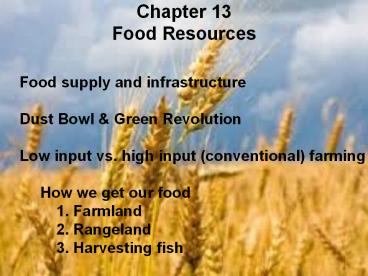Chapter 13 Food Resources - PowerPoint PPT Presentation
1 / 21
Title:
Chapter 13 Food Resources
Description:
Title: Chapter 11 Agriculture and the Environment Key terms: Food supply and infrastructure GMC Agroecosystems vs. nature ecosystems Sustainable management of ... – PowerPoint PPT presentation
Number of Views:276
Avg rating:3.0/5.0
Title: Chapter 13 Food Resources
1
Chapter 13Food Resources
Food supply and infrastructure Dust Bowl Green
RevolutionLow input vs. high input
(conventional) farming How we get our food 1.
Farmland 2. Rangeland 3. Harvesting fish
2
FactsFood Supply and Distribution
- Humans require 2,000 to 2500 calories a day
- Wheat and rice supply half calorie intake
- worldwide
- 90 grain grown in U.S is for animal feed!
- Developing countries are more eating meat
3
Undernutrition and Malnutrition1 in every 6
Undernourishment- lack of sufficient calories
Resulting in stunted growth, mental retardation,
susceptible to disease Malnourishment- long-term
lack of specific component of food Marasmus
waste away emaciation (lack calories
protein) Kwashiorkor displaced child After
age 1-3 yrs. Weaned given grain lack protein
results in neurological failure Chronic hunger
enough food to live (but not satisfactory
life)
4
gt 1/3 population
5
Developed countries spend less on food
6
Arable Farmland
7
(No Transcript)
8
Countries Receiving Food Aide
Ethiopia (19 percent), Pakistan (10 percent),
Kenya (7 percent), the Sudan (5 percent),
Mozambique (4 percent), Somalia (4 percent),
Afghanistan (3 percent) DRC (3 percent).
9
Food Aide
- Is Food aide the answer to food shortages?
- Infrastructure
- Develop local markets?
- Increase local production?
10
What we eat
- 14 crops- wheat, maize, rice, potatoes, sweet
potatoes, manioc, sugarcane, sugar beets, common
beans, soybeans, barley sorghum, peanuts
11
The Dust Bowl
- Dirty Thirties- period of severe drought and
dust storms - Lack conservation practices to prevent erosion-
plowing up down slope - Deep plowing of virgin topsoil in grasslands
- Affected 100 million acres in Texas and Oklahoma,
New Mexico, Colorado, and Kansas - Millions of acres of farmland became useless
- Many traveled to California, farm to farm picking
fruit at starvation wages.
12
- Plowing during Dust Bowl Era
- Modern Plowing
Clearing field Plowing up/down slope
Contour plowing
Modern Plowing
13
Conservation Service created in 1938 to help
farmers save soil by preventing erosion
Cover crop of summer rye grass Adds N Prevents
erosion Adds organic matter
Crop rotation Decrease pesticide Decrease
fertilizer use
14
Conservation Practices
Integrated pest management
- Decrease pesticide use
- By surveying field for pests
- Spray pesticide only when necessary
- Use beneficial pets
No-till farming Plant new seeds in stubble of
last years crop
- Reduce plowing trips across field
- Reduce use fossil fuel
- Reduce greenhouse gas emissions
15
Conservation Practicesfor Irrigation
Drip irrigation
- Less water use
- Water goes to plant not runoff
- More water use
- More water runoff
- More evaporation
16
The Green Revolution
- Todays style of agriculture began after WWII,
Green Revolution - Overcoming lands limiting factors
- High yields , on smaller acreages, mechanization,
hybrids, pesticides, synthetic fertilizer - Monocultures
- Increase in fossil fuel use
17
Todays agriculture
- Industrialized (high input)- 25 of cropland
mostly practiced in developed countries - Large amounts of
- Fertilizers
- Water
- Fossil fuels
- Pesticides
18
Modern agriculture is not energy efficient10
units fossil fuel per 1 unit food energy
Storage and prep Commercial food
service Retail Packaging Processing Transportati
on Production
19
Fossil fuel needed in industrialized meat
production
20
Sustainable AgricultureLow input or organiclt1
of worlds cropland
- Increases
- Polyculture
- Organic fertilizers
- Integrated pest management
- Irrigation efficiency
- Crop rotation
- Soil conservation
- Decreases
- Soil Erosion
- Soil salinization
- Overgrazing
- Loss of biodiversity
- Aquifer depletion
- CO2 emissions
21
Microlivestock































